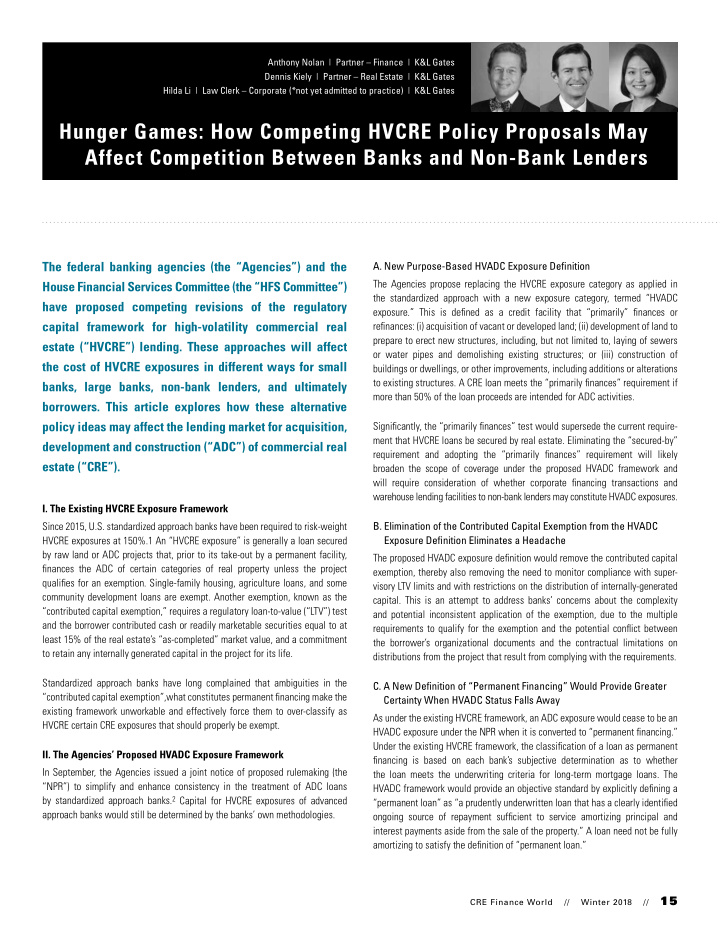



Anthony Nolan | Partner – Finance | K&L Gates Dennis Kiely | Partner – Real Estate | K&L Gates Hilda Li | Law Clerk – Corporate (*not yet admitted to practice) | K&L Gates Hunger Games: How Competing HVCRE Policy Proposals May Affect Competition Between Banks and Non-Bank Lenders The federal banking agencies (the “Agencies”) and the A. New Purpose-Based HVADC Exposure Definition The Agencies propose replacing the HVCRE exposure category as applied in House Financial Services Committee (the “HFS Committee”) the standardized approach with a new exposure category, termed “HVADC have proposed competing revisions of the regulatory exposure.” This is defined as a credit facility that “primarily” finances or capital framework for high-volatility commercial real refinances: (i) acquisition of vacant or developed land; (ii) development of land to prepare to erect new structures, including, but not limited to, laying of sewers estate (“HVCRE”) lending. These approaches will affect or water pipes and demolishing existing structures; or (iii) construction of the cost of HVCRE exposures in different ways for small buildings or dwellings, or other improvements, including additions or alterations to existing structures. A CRE loan meets the “primarily finances” requirement if banks, large banks, non-bank lenders, and ultimately more than 50% of the loan proceeds are intended for ADC activities. borrowers. This article explores how these alternative policy ideas may affect the lending market for acquisition, Significantly, the “primarily finances” test would supersede the current require- ment that HVCRE loans be secured by real estate. Eliminating the “secured-by” development and construction (“ADC”) of commercial real requirement and adopting the “primarily finances” requirement will likely estate (“CRE”). broaden the scope of coverage under the proposed HVADC framework and will require consideration of whether corporate financing transactions and warehouse lending facilities to non-bank lenders may constitute HVADC exposures. I. The Existing HVCRE Exposure Framework Since 2015, U.S. standardized approach banks have been required to risk-weight B. Elimination of the Contributed Capital Exemption from the HVADC HVCRE exposures at 150%.1 An “HVCRE exposure” is generally a loan secured Exposure Definition Eliminates a Headache by raw land or ADC projects that, prior to its take-out by a permanent facility, The proposed HVADC exposure definition would remove the contributed capital finances the ADC of certain categories of real property unless the project exemption, thereby also removing the need to monitor compliance with super- qualifies for an exemption. Single-family housing, agriculture loans, and some visory LTV limits and with restrictions on the distribution of internally-generated community development loans are exempt. Another exemption, known as the capital. This is an attempt to address banks’ concerns about the complexity “contributed capital exemption,” requires a regulatory loan-to-value (“LTV”) test and potential inconsistent application of the exemption, due to the multiple and the borrower contributed cash or readily marketable securities equal to at requirements to qualify for the exemption and the potential conflict between least 15% of the real estate’s “as-completed” market value, and a commitment the borrower’s organizational documents and the contractual limitations on to retain any internally generated capital in the project for its life. distributions from the project that result from complying with the requirements. Standardized approach banks have long complained that ambiguities in the C. A New Definition of “Permanent Financing” Would Provide Greater “contributed capital exemption”,what constitutes permanent financing make the Certainty When HVADC Status Falls Away existing framework unworkable and effectively force them to over-classify as As under the existing HVCRE framework, an ADC exposure would cease to be an HVCRE certain CRE exposures that should properly be exempt. HVADC exposure under the NPR when it is converted to “permanent financing.” Under the existing HVCRE framework, the classification of a loan as permanent II. The Agencies’ Proposed HVADC Exposure Framework financing is based on each bank’s subjective determination as to whether In September, the Agencies issued a joint notice of proposed rulemaking (the the loan meets the underwriting criteria for long-term mortgage loans. The “NPR”) to simplify and enhance consistency in the treatment of ADC loans HVADC framework would provide an objective standard by explicitly defining a by standardized approach banks. 2 Capital for HVCRE exposures of advanced “permanent loan” as “a prudently underwritten loan that has a clearly identified approach banks would still be determined by the banks’ own methodologies. ongoing source of repayment sufficient to service amortizing principal and interest payments aside from the sale of the property.” A loan need not be fully amortizing to satisfy the definition of “permanent loan.” CRE Finance World // Winter 2018 // 15
Recommend
More recommend